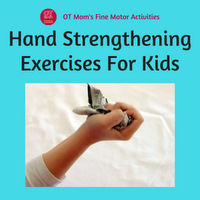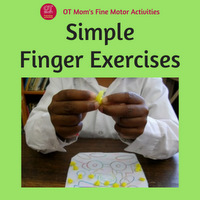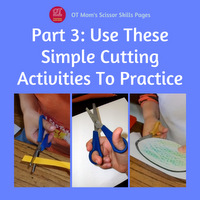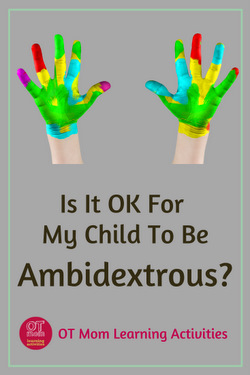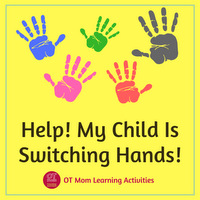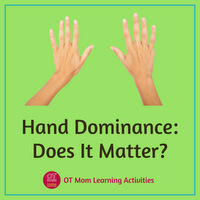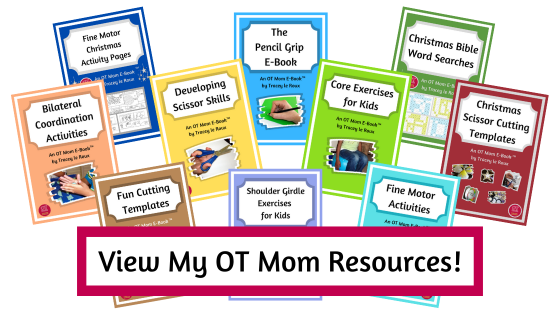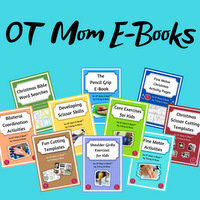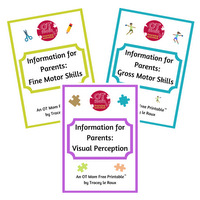- Home Page
- Hand Dominance
- Is My Child Ambidextrous?
Is It OK For My Child To Be Ambidextrous?
Is it OK for my child to be ambidextrous?
Is it OK for my child to be using both hands?
I have heard these questions quite a few times! Sometimes parents of kids who are switching hands have asked, and at other times I have heard the questions from adults who enjoy their ambidexterity and want their kids to be the same!
I sometimes link to products (#Ad) that are similar to those I use and love. If you do purchase something through my links, I will receive a small commission that helps support my site - thank you!
I am going to try to answer this question from an occupational therapy point of view.
This page covers:
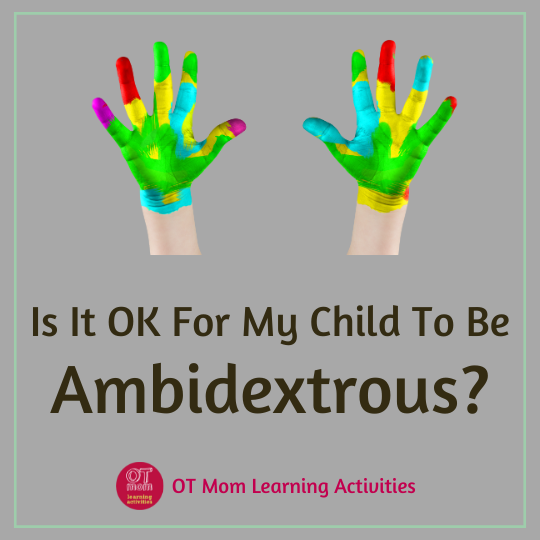
This page is not a substitute for an occupational therapy evaluation and treatment if you are at all concerned about your child's development!
Is Your Child's Function Affected?
Occupational therapists are concerned with function – in a nutshell, we ask “Can this person carry out the work he/she needs to do, and if not, how can we help achieve this goal?”.
The work of children is to play, learn self care, and to enter a world of learning, that includes reading, writing and calculating.
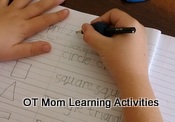 Is handwriting affected?
Is handwriting affected?If anything is hindering a child from being able to play effectively, from carrying out self care tasks, or holds a child back from learning efficiently, then an occupational therapist will try to get to the bottom of the causes.
When
a teacher picks up that a child is switching hands when holding a
pencil, or when cutting with scissors, it is a concern because the child
will probably be falling behind his or her peers in those activities.
So if your child keeps switching hands when using a pencil or scissors, then your child is not learning to specialize a hand for that task.
Learning to control a pencil in order to draw and write takes a lot of fine motor control. If your child is spending a lot of mental and physical effort in learning to control the pencil, there is less energy to spare for the actual learning process. When one hand is used consistently for a task, then that hand usually becomes specialized in the task.
The occupational therapist would want to help your child to become efficient and effective at controlling the pencil and for this reason, and would want to figure out which hand is your child’s dominant or specialized hand for the task.
Once the hand “dominance” has been established, the occupational therapist would then work on helping that hand become proficient and efficient at using scissors and pencils.
Ambidextrous? Mixed Handedness?
The definition of true ambidexterity is being able to do a task equally well with either hand or with both hands at the same time (Oxford Dictionary).
Unfortunately, most of the kids who get referred for OT assessments are not doing the task equally well with either hand – they are doing the task badly no matter which hand they use! And because of this, they are at risk of falling behind their peers in the classroom, which is why the teacher is concerned.
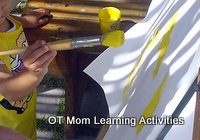 Painting With Right Hand
Painting With Right Hand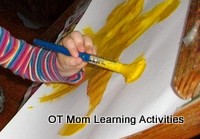 Painting With Left Hand
Painting With Left HandIn my correspondence with those promoting ambidexterity, they have often referred to famous “ambidextrous” people such as cricketer Sachin Tendulkar, who uses his left hand for writing, and his
right hand for batting and bowling. Tennis player Rafael Nadal uses
his right hand for writing but plays tennis with his racquet in his left
hand (Wikipedia).
I would say that these people may not be truly ambidextrous,
because the quality of their writing may likely not be the same with
either hand, and the quality of their cricket or tennis playing may likely not be the same with either hand. (I stand open to correction on this, though!)
A better term to describe them may be “mixed handed” – where certain tasks are carried out well with one hand and other tasks more proficiently with the other hand. The point is that one hand has become specialized in a specific task!
Recent Studies
Recent research suggests that handedness occurs on a continuum, with strongly right-handed people at one end of the continuum, and strongly left-handed people at the other end of the continuum. These people consistently use one specialized hand across a variety of tasks. Research literature is beginning to refer to such people as being “consistently right handed” or “consistently left handed”.
In between these 2 ends of the spectrum, are people who are referred to as “inconsistently left handed” or “inconsistently right handed” – this means that they tend to use one hand for some tasks and the other hand for other tasks. (Examples of tasks used in the research included writing, brushing one’s teeth, combing one’s hair, throwing a ball and cutting with scissors.)
Researching handedness in this way (on a continuum) is still a fairly recent occurrence, and new findings are emerging.
Some of these studies point out advantages that “inconsistent handed” people seem to enjoy, which is possibly owing to better interaction (communication) between the two hemispheres of the brain. Other studies have pointed out that “mixed handed” children may struggle more with some aspects of learning in the early years of school.
You may wish to read more on these studies for yourself - these are some of the articles I found helpful:
- Zago, L., et al. (2015) The association between
hemispheric specialization for language production and for spatial
attention depends on left-hand preference strength. Neuropsychologia (2015). http://dx.doi.org/10.1016/j.neuropsychologia.2015.11.018
- Christman,
S.D., Prichard, E. C., Corser, R. (2015). Factor analysis of the
Edinburgh Handedness Inventory: Inconsistent handedness yields a
two-factor solution. Brain and Cognition (August 2015). http://dx.doi.org/10.1016/j.bandc.2015.06.005
- Prichard, E.; Propper, R.E; and Christman, S.D. (2013) Degree of Handedness, but not Direction, is a Systematic Predictor of Cognitive Performance. Frontiers in Psychology (January 2013). http://dx.doi.org/10.3389/fpsyg.2013.00009
So, What Should I Do?
If your child is about to enter formal schooling (age 5-6) and has not yet developed a specialized hand for using a pencil and cutting with scissors, then I really recommend that you take your child to an occupational therapist, who can assess your child and help take the necessary steps as soon as possible.
Once it has been established which hand your child needs to use for writing and cutting, then, in consultation with your OT, give your child as much practice as possible in developing the strength and dexterity of the chosen hand.
Try these hand exercises, finger exercises and easy cutting activities to build the skills of the preferred hand. You may even notice an improvement in self care skills (doing buttons, eating with a knife and fork) as your child's preferred hand improves in its skill and dexterity.
You can also read about a few underlying reasons why a child may be switching hands and what to do about it.
I hope you found this article helpful! Why not sign up for my occasional, free newsletter to keep in touch with new and updated pages on my site?
Please do share the page if you found it to be helpful!
- Home Page
- Hand Dominance
- Is My Child Ambidextrous?
Share this page to help others!
Related Pages On My Site
Further Resources and References
1. Oxford Dictionary https://en.oxforddictionaries.com/definition/ambidextrous (retrieved 06 March 2017)
2. McDougall, Bunty. Ambidextrousness - why one hand is better than two. 9 September 2016 (retrieved 25 February 2017)
Didn't find what you were looking for? Try a search of my site!
